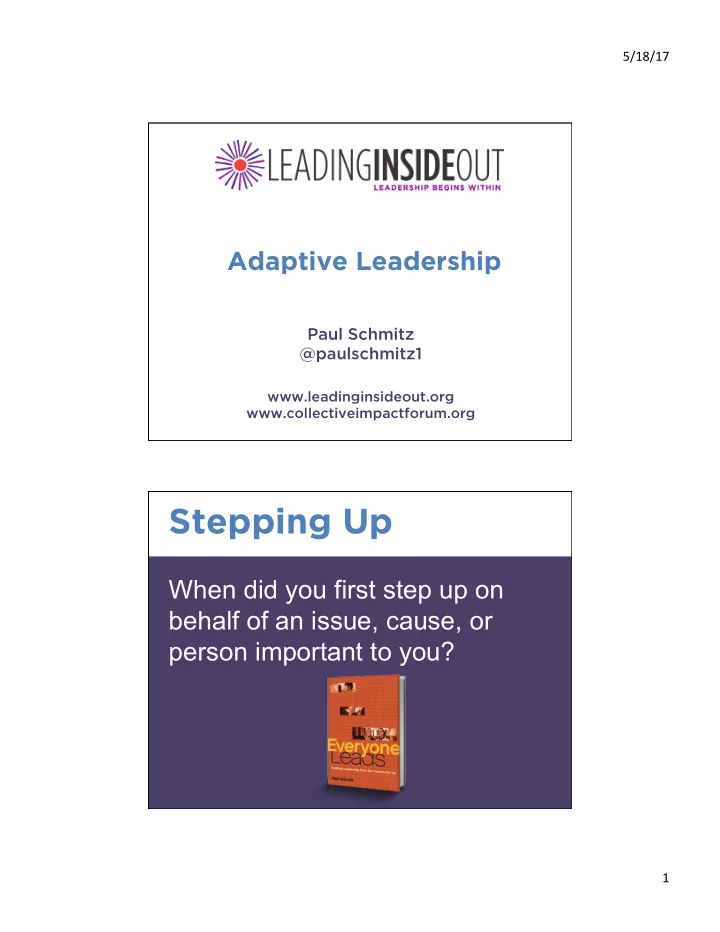

5/18/17 Adaptive Leadership Paul Schmitz @paulschmitz1 www.leadinginsideout.org www.collectiveimpactforum.org Stepping Up When did you first step up on behalf of an issue, cause, or person important to you? 1
5/18/17 Defining Leadership 1 An action many can take, not a position few can hold 2 Taking responsibility to work with others on common goals 3 Practice of values that engage commitment from others A Leadership Story 2
5/18/17 Who was the leader? Social Change has always come from the leadership of the many Who was the leader? What lessons can you draw about distributed leadership? 3
5/18/17 Defining Leadership 1 An action many can take, not a position few can hold 2 Taking responsibility to work with others on common goals 3 Practice of values that engage commitment from others LUNCH Reconvene at 12:45 PM 4
5/18/17 Symbols 1 When you think of the big challenges before you, you feel like (a) Pushing a boulder up a hill (b) Maze (c) Candle (d) Space Shuttle Symbols 2 When you think of your role currently in working on these challenges, you feel like a: (a) Giraffe (b) Owl (c) Butterfly (d) Horse 5
5/18/17 Symbols 3 When you think of capacities you need to address your biggest challenges, you think of: (a) Compass (b) Swiss Army Knife (c) Football (d) Kite Symbols Debrief What are 3 challenges your team is facing? 6
5/18/17 Adaptive Leadership Technical Challenges Expertise, past experience, existing capacity Adaptive Challenges Outside of expertise, experience, capacity; change in people’s habits, beliefs, loyalties Adaptive Challenges • Gap between stated values/aspirations and actions • Outside our current capacity and technical knowledge • Competing interests/priorities • New stakeholders must be engaged • People must work across boundaries • Di ffi cult learning required • Elephants in the room – much is unspoken • Nonlinear progress is required • Recurring problem • There are casualties and losses • Emotionally fraught • Work avoidance is main response 7
5/18/17 Work Avoidance Diverting Attention • Focus only on technical parts and technical fixes • Define problem to fit capacity • Turn down heat on discussion • Deny problem exists • Create a proxy fight, like a personality conflict • Take options o ff the table to honor legacy behaviors Displacing Responsibility • Marginalize person raising the issue • Scapegoat someone • Externalize enemy • Attack authority • Delegate adaptive work to those who can’t do anything about it Adaptive Leadership 1. Resist leap to action 2. Get o ff the dance floor and move to the balcony 3. Separate technical from adaptive challenges 4. Share alternate interpretations; understand and test mental models 5. Observe, Diagnose, Hypothesize, Propose; identify burdens of proof and tradeo ff s 6. Manage people’s adaptive capacity 8
5/18/17 Mental Models Ladder of Inference 18 9
5/18/17 Adaptive Leadership 1. Resist leap to action 2. Get o ff the dance floor and move to the balcony 3. Separate technical from adaptive challenges 4. Share alternate interpretations; understand and test mental models 5. Observe, Diagnose, Hypothesize, Propose; identify burdens of proof and tradeo ff s 6. Manage people’s adaptive capacity Managing Change 1. Recognize di ff erent adaptive capacities 2. Signal early 3. Focus less on your excitement about the change; more on empathy for other’s stress 4. Disclose how and why decisions were made 5. Acknowledge trade-o ff s and losses 6. Clearly describe change process 10
5/18/17 Managing Conflict Work on easier problems Call the question Give people more Reclaim responsibility responsibility Break problem up Bring conflict to surface Tolerate provocations Employ work avoidance Name dynamics Slow down The Practice of Adaptive Leadership , Heifetz, Alinsky, Grashow Leadership Styles Visionary Nurturer Mobilizer Analyst What is your leadership style? Why do you need the others? 11
5/18/17 Leadership for Collective Impact Paul Schmitz www.leadinginsideout.org www.collectiveimpactforum.org 12
Recommend
More recommend